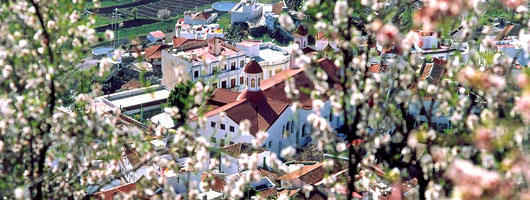The most typical fruit grown around Tejeda gives its name to the town’s main festivities: the Festival of the Almond Trees in Flower. These celebrations, which are held during the first two weeks in February, were first organised by the young people of the municipality in 1970.

They were created as a way of preserving and promoting the local traditions and culture of the municipality, and of the island. Canary Island folklore at its best can be enjoyed at this festival: traditional dance and music, handicrafts, local sports, livestock and agricultural fairs and a demonstration of the typical tasks carried out in the area which Tejedenses and visitors alike love to watch.
The Fiestas of the Virgen del Socorro, the patron of Tejeda, are held from the second week in September onwards. Her image is venerated in the parochial church, which has been named after Her. During the main day of the fiestas there is a procession, and offerings of local produce are made to the Virgin by the people who live in the town and surrounding areas.
Once the period of the monarchies with the Guanartematos (local kings) came to a close, a feudal system was set up on the island which divided it into different “states” ruled over by a caudillo or chief. Tejeda was governed by Texeda, from whom the municipality got its name.

This is why at the Roque Bentayga, a natural monument belonging to Tejeda, we can find different archaeological remains, among which there is an Almogarén (ancient sanctuary). All these remains lead us to think that before the conquest, this area was home to a large population.
When the conquerors of Gran Canaria reached this far inland, they began to share out land and water. Once the conquest was over, around the mid eighteenth century, Tejeda already had over one thousand inhabitants. Nevertheless, as the area was far away and communications with administrative and financial centres were poor, living there posed a number of drawbacks. This is why at the beginning of the 17th century distance made it necessary to provide Tejeda with its own priest and to turn the small church into a parish which would serve most of the western part of the area, that is, the mountains and medianías of Gran Canaria.

During the 16th and 17th centuries, the economy of the area came from three main sources; agriculture, with the most important crops being wheat, maize and potatoes; the stockbreeding of sheep and goats; and thirdly, exploitation of the forest. Thanks to its hydraulic wealth the forest was important, which is why part of the land in the area still remained in the hands of the Crown.
In the 18th and 19th centuries illegal tilling of land was carried out as an increase in population led to an ever growing need to acquire land for cultivation.
The municipality of Tejeda is situated in the centre-east of Gran Canaria and covers an area of about 104 square kilometres. The centre of the village of Tejeda stands at an altitude of 1.050 metres above sea level while the Pico de las Nieves, the highest point of the island, reaches a height of 1.949 metres.
The exact distance from Las Palmas along the GC15 is 43.7 kilometres and this is the most usual route to get to the municipality. However, it is also possible to get there from the south, via Fataga, although the route is slightly longer.


As Tejeda lies in the centre of the island, from almost all parts of the municipality you can see the geological symbols of the island: the Roque Nublo (1.813m) and the Roque Bentayga, which were of religious importance in pre-hispanic times. These two peaks stand high above the great geographic depression of Tejeda which was formed by a huge sunken caldera. This caldera has been eroded by water and volcanic action. Above Tejeda rises a mountain crowned by a series of rocks, besides those previously mentioned.
Tejeda is surrounded by vast extensions of Canary Island pines, which are intermingled with what is now left of an enormous colony of almond trees.
At the end of the 19th century, there was an increase in the amount of land that could be cultivated following the confiscation of land from the regular and secular clergy. Dry-farmed produce such as cereals and fruit trees (which did not need irrigation) covered the largest area. It was at this time that the almond trees were beginning to acquire great importance in the municipality.
Although agriculture is still an important sector for the basic economy of the municipality, the majority of the inhabitants of Tejeda work in the tertiary sector.
Farming around Tejeda is rich in dry-farmed produce such as potatoes, fruit, cereals, legumes, almonds and fodder. There are also tracts of irrigated land which produce vegetables and fruit trees.
Part of the economy of Tejeda is spent on rearing and fattening cows and pigs. Money is also spent on the homemade food industry, especially on the typical sweets which use almonds as the main ingredient.